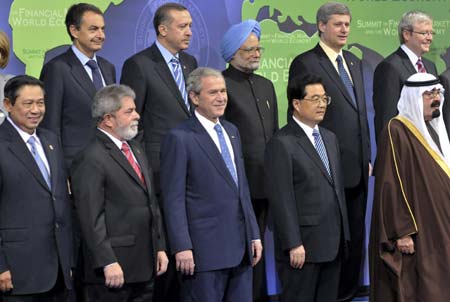Mind the Gap
According to Swedish professor in International Health and distinguished TED-speaker Hans Rosling many of us have an outdated conception of the world’s economic situation. At a recent lecture at the University of Oslo Rosling pointed out that while the USA, straight after the outbreak of the recent economic crisis, became in debt to Brazil, countries in the west including Norway provide monetary support to Brazil. The picture below was taken at an economic summit hosted by then president George W. Bush, and as pictures are important memories from such events, it is interesting to look closer at the location of the participants. Next to the American president – the leader of the only superpower at the end of the 20th century – stands a socialist and a communist from the emerging BRIC-countries. There is something different with this picture compared with similar pictures from other summits. Twenty five years ago the real economic world, for many, ended just west of Brandenburger Gate. Now the western world is just a geographical region, among many, where a minority of the people and economic players in the global world lives. At the G20 Summit on Financial Markets and the World Economy is when, Rosling said, whe the Second World War ended. The world view which followed the largest war of the 20th century is now obsolete.

A fact-based world view is what Rosling promotes, and by presenting economic, health, technology and other indicators of human conditions with scatterplots in a cartesian space he is very convincing. According to Rosling, many of us (in the west?) believe in a world view that expired twenty five years ago. Contextualised with compelling stories the arguments are strong and the pedagogic presentation in world class.
An argument Rosling refutes, and which I found especially interesting as many advocate this argument, is that world population will rise. It will rise, and the reason this will happen is that people live longer and fewer die. The world population has risen considerably between 1950 and 2012, and at the end of the century it will stabilize. At this point just half a billion will live in Europe, the same amount that will live in North-America. Asia will still be the most populous continent closely followed by Africa, and it is on this continent the biggest increase in population will be found. The counter-argument goes: the problem is not really the increase in population, as this increase will find place in the parts of the world where consumption is lowest. A doubling of the ‘electric light’- population (those who no longer use fire to light their homes, but still cannot afford washing machines) will not increase the global strain on resources as they use just a minor part of what is consumed by the ‘jet fly’-part. The problem is not that a coal fueled power station is built in India to give light to 1 million people, but that the population of Oslo is driving cars to work and throw food. The world could not sustain a doubling of the ‘jet fly’-part (those whom increased energy consumption does not lead to better conditions – living conditions are saturised) of the population as they use six times as much power as the ‘electric light’-part. The cuts for a sustainable world has to be made where consumption is not just a necessity, but mainly driven by luxury.
To paraphrase Rosling: George W. Bush has understood the new world order, and if Bush can do it, you can too!
Article picture is by Stefan Nilsson, available on the GapMinder homepage